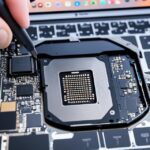Resolving MacBook Boot-Up Problems
If you encounter boot-up problems with your MacBook, it can be frustrating and inconvenient. There are several possible reasons why your Mac won’t boot, such as hardware issues, software corruption, errors during the startup process, or power connectivity problems. In this article, we will provide you with troubleshooting methods to fix common MacBook boot-up problems and get your Mac back up and running smoothly.
In today’s technology-driven world, MacBook boot-up problems can greatly hinder your productivity. Whether you rely on your Mac for work or personal use, it’s essential to quickly resolve any startup issues to avoid downtime and potential data loss.
From Mac won’t boot to MacBook not turning on, we understand the urgency of finding solutions to these frustrating problems. Our comprehensive guide will walk you through the troubleshooting steps needed to get your MacBook back on track.
By following our expert advice, you’ll be equipped with the knowledge to effectively troubleshoot and fix common startup issues. Say goodbye to the frustration of staring at a blank screen or being greeted with error messages every time you turn on your Mac.
Stay tuned as we dive into specific troubleshooting methods, check power and connections, and explore data recovery options for Mac boot-up issues. Let’s get your MacBook up and running again!
Checking Power and Connections
Before diving into more in-depth troubleshooting methods, it’s important to check the power connection of your Mac. Ensure that your Mac is plugged in and receiving power. Sometimes, the power cord may become unplugged, resulting in the Mac not turning on. Additionally, external accessories like peripherals can sometimes cause issues with booting. It’s recommended to unplug all external devices except for the power cable and try booting again. If you recently experienced a power outage, it’s worth trying a different power cable or visiting an Apple Store for assistance.
Ensuring a proper power connection is crucial for resolving MacBook boot-up problems. Follow the steps below to check your power connection:
Steps to Check Power Connection:
- Make sure your Mac is properly plugged into a power outlet.
- Check the power cable for any signs of damage.
- Verify that the power cord is securely connected to both the power outlet and your Mac.
- If you are using a power strip or surge protector, try plugging your Mac directly into the power outlet.
In addition to checking the power connection, it’s essential to disconnect any external accessories and peripherals, excluding the power cable. Sometimes, external devices can interfere with the Mac’s startup process. By disconnecting them, you can eliminate potential conflicts and troubleshoot more effectively.
If you recently experienced a power outage and your Mac is still not turning on, consider trying a different power cable as a precautionary measure. It’s possible that the original power cable may have been affected by the power surge during the outage.
Remember, if your Mac still won’t turn on after performing these power and connection checks, it’s advisable to seek professional assistance at an Apple Store or authorized service center to diagnose and resolve the issue.
| Issue | Solution |
|---|---|
| Unplugged Power Cord | Ensure that the power cord is securely connected to both the power outlet and your Mac. |
| External Accessories Interference | Disconnect all external accessories and peripherals, except the power cable, and try booting again. |
| Power Outage | If you recently experienced a power outage, consider trying a different power cable. |
Note: It’s important to use caution when handling power cables and consult professional assistance if you are unsure about any electrical connections.
Troubleshooting Methods for Startup Issues
If your Mac still won’t boot after checking the power connection, there are several troubleshooting methods you can try. If you see a question mark or prohibitory symbol during startup, it indicates issues with the startup disk. You can reset the NVRAM on your Mac or select the preferred startup disk in Startup Disk preferences. If these steps don’t resolve the issue, you can use Disk Utility to repair the disk or boot into Recovery Mode to reinstall macOS. These methods can help fix software or hardware-related startup problems.
Reset NVRAM
If you’re experiencing startup issues on your MacBook, resetting the NVRAM (Non-Volatile Random-Access Memory) can potentially resolve the problem. NVRAM stores certain settings and preferences, and resetting it can clear any incorrect or corrupted data that may be causing the startup problem.
- Turn off your MacBook and then press the power button to turn it on.
- Immediately press and hold the Command (⌘) + Option (⌥) + P + R keys simultaneously.
- Continue holding the keys until you hear the startup sound for the second time.
- Release the keys and let your MacBook boot normally.
Select Preferred Startup Disk
In some cases, the startup disk selection may be causing issues with booting your MacBook. By selecting the preferred startup disk in Startup Disk preferences, you can ensure that your Mac starts up using the correct disk.
- Go to the Apple menu and select “System Preferences”.
- Click on “Startup Disk”.
- Select the disk you want your Mac to start up from.
- Restart your Mac and check if the startup issue is resolved.
Repair Disk with Disk Utility
If there are disk-related issues causing the startup problem, you can use Disk Utility to repair the disk.
- Start your Mac in Recovery Mode by restarting it and holding down Command (⌘) + R until the Apple logo appears.
- Open Disk Utility from the macOS Utilities window.
- Select your startup disk from the list.
- Click on the “First Aid” tab and then click “Run” to start the disk repair process.
- Once the repair is complete, restart your Mac and check if the startup problem is resolved.
Boot into Recovery Mode
If the previous methods didn’t fix the startup issue, you can try booting your Mac into Recovery Mode to reinstall macOS.
- Restart your Mac and hold down Command (⌘) + R until the Apple logo or a spinning globe appears.
- Select your language and click “Continue”.
- In the macOS Utilities window, select “Reinstall macOS”.
- Follow the on-screen instructions to complete the reinstallation process.
Data Recovery for Mac Boot-Up Issues
If you encounter a Mac boot-up problem and want to recover your data, it’s recommended to use third-party data recovery software like Disk Drill. Disk Drill is a powerful tool that can recover data even if it has been deleted or if there are hardware or software issues. It’s important to recover your files to an external hard drive to ensure their safety. Follow the instructions provided by Disk Drill to scan and recover the data from your Mac.
If your Mac experiences a boot-up issue, it can lead to potential data loss. Whether it’s due to a hardware malfunction, software corruption, or any other reason, Disk Drill can assist in retrieving your valuable files. Disk Drill is equipped with advanced algorithms that can recover various file formats from different storage devices, including Macs.
To begin the data recovery process, install Disk Drill on a separate Mac or an external bootable drive. Connect the affected Mac to the device with Disk Drill installed and follow the step-by-step instructions provided by the software. Disk Drill will scan your Mac for recoverable data, allowing you to preview and select the files you wish to recover.
It’s crucial to recover the data to an external hard drive or a different storage device to prevent overwriting or further data loss. Disk Drill helps minimize any potential risks during the recovery process by ensuring the recovered files are safely stored in a separate location.
Remember that the success of data recovery depends on various factors, such as the extent of data damage and the actions taken after experiencing the boot-up problem. If you’re unable to retrieve your data using Disk Drill or face additional challenges, it’s advisable to seek professional assistance from data recovery specialists.
Conclusion
In conclusion, encountering boot-up problems with your MacBook can be challenging, but there are effective solutions available to resolve startup issues. This article has provided you with essential troubleshooting methods to help you troubleshoot and fix common MacBook boot-up problems. By checking power connections, troubleshooting startup issues, repairing disk problems, and utilizing data recovery software, you can overcome these obstacles and get your Mac back up and running smoothly.
Remember, it is crucial to regularly back up your data to prevent loss during boot-up issues. Data recovery can be performed using reliable third-party software like Disk Drill, which allows you to recover deleted files and restore data from hardware or software-related problems. By following the instructions provided by Disk Drill, you can scan and recover your valuable data to an external hard drive for safekeeping.
If you find yourself unable to resolve the boot-up problem on your own, it is advisable to seek professional assistance from an Apple Store or qualified service provider. They have the knowledge and expertise to diagnose and fix more complex issues that may require hardware repairs or further troubleshooting.












